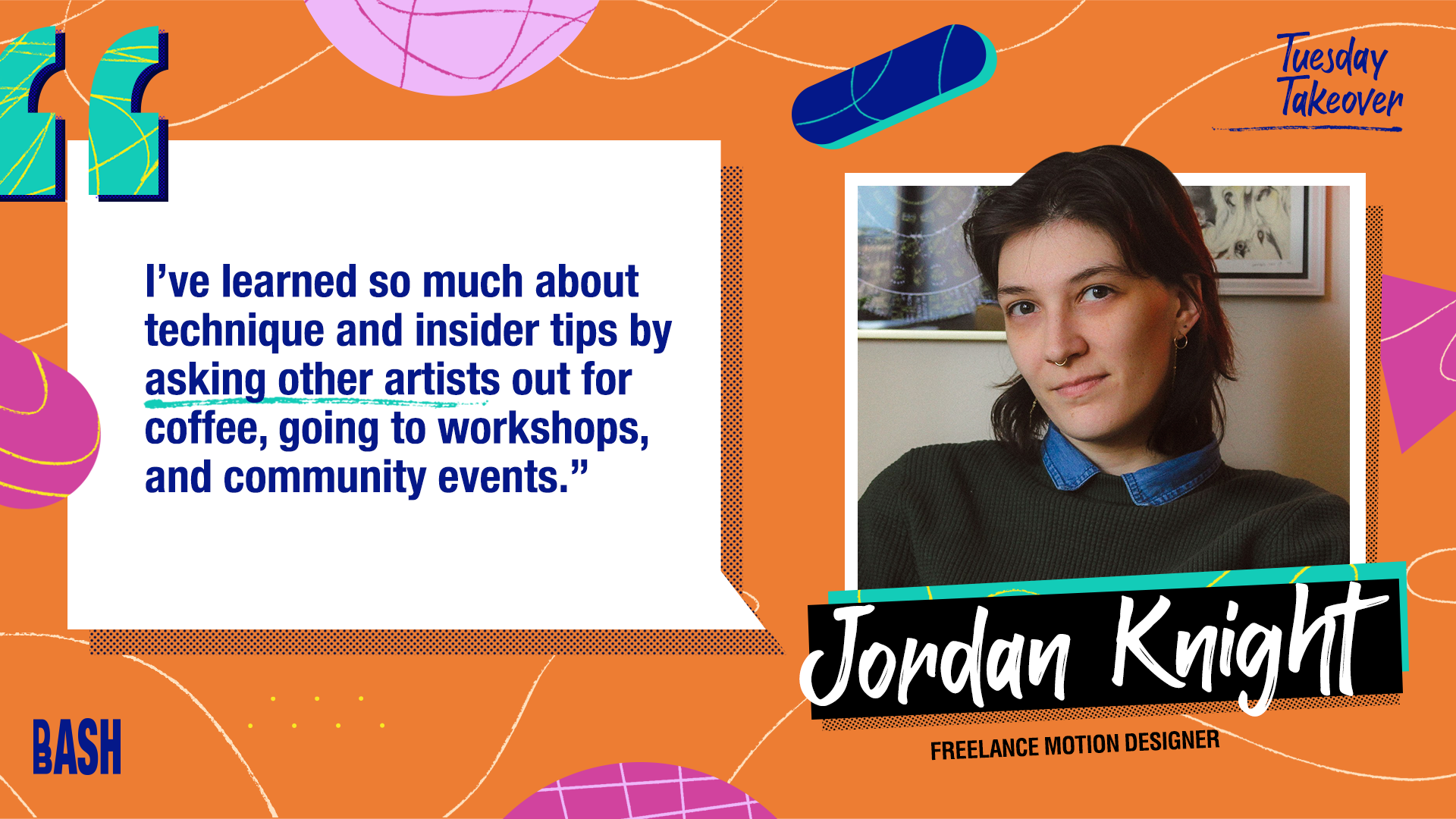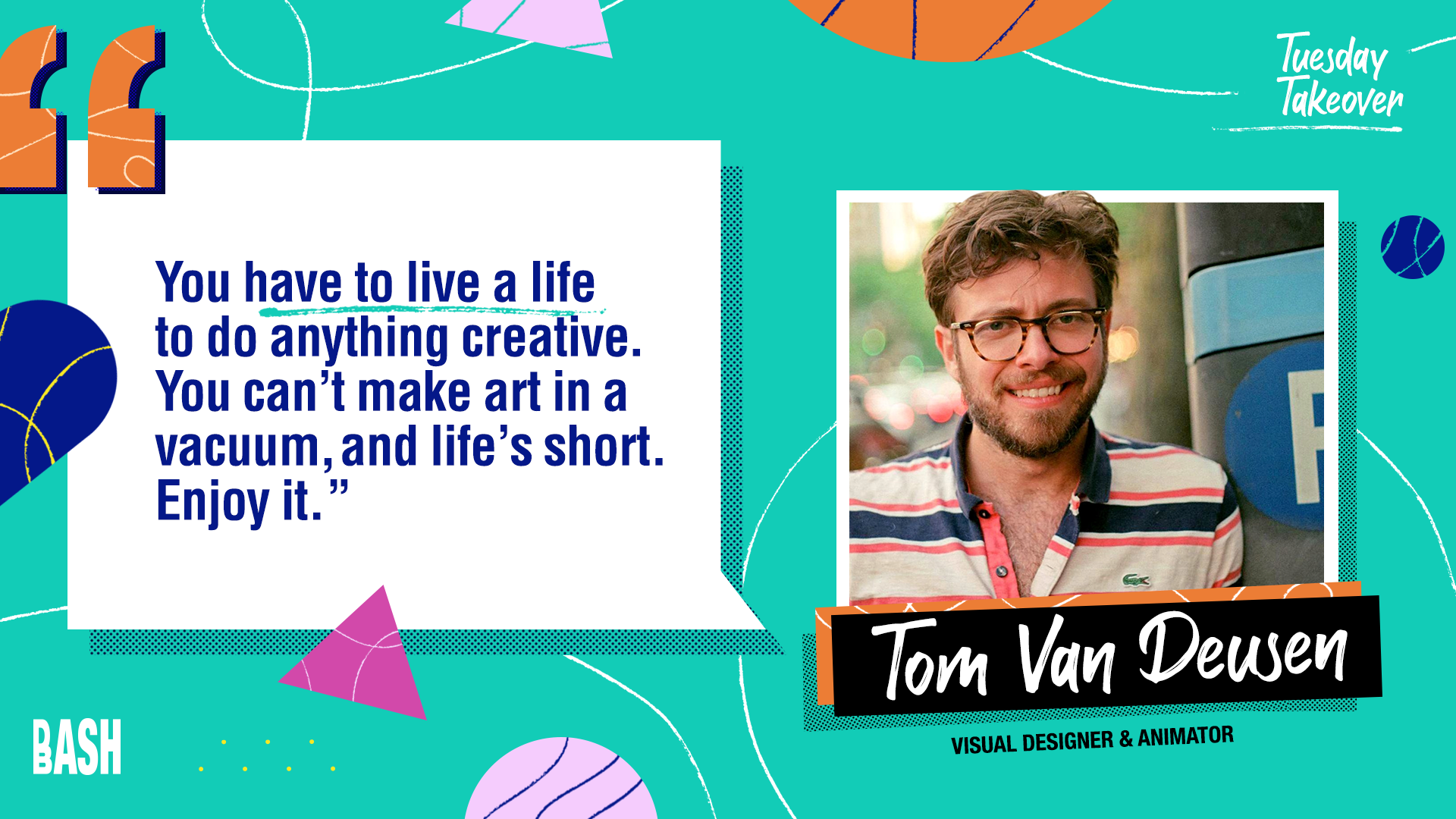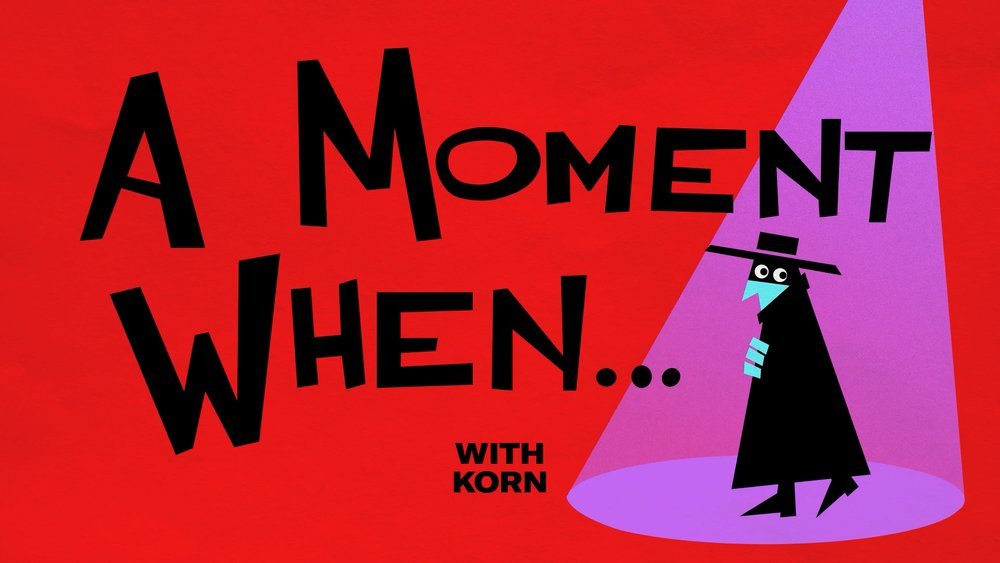Takeover Tuesday with Jordan Knight
An interview with Jordan Knight: a multi-media designer, animator, illustrator who has worked with clients all over the commercial, social media, and entertainment world.
Interviewer: Bella Alfonsi
Read time: 5min
Bella:
Thanks for joining us for Takeover Tuesday, Jordan! Can you please introduce yourself?
Jordan:
Hi! I’m Jordan Knight, I’m a motion designer based out of Brooklyn but originally from upstate New York and I’ve worked as a freelancer for the majority of my career. I am also queer, I like to bike (as a commuter mostly), love a painting exhibit (late 19th century is my favorite), and I also have a pet snake.
Bella:
How did you get into the motion design world?
Jordan:
In school I had much more patience for art and drawing than any other subject, and I loved movies. So animation felt like a convenient way to mix both of my interests. I went to SCAD for an animation degree and when I was 90% of the way through I took an intro class for After Effects and only learned then about motion design. I thought there was so much more room to grow as an experimental designer in that industry, which I eventually realized was such a huge priority for me in my own creative process. So I made the choice to switch gears after graduation. It took a few transitional years of working as a graphic designer for bodegas and bars, as a studio manager for a small agency, and then slowly working on my after effects confidence on the side to get to a point where I felt I was ready to try taking on a freelance job. I made a lot of mistakes, but I learned a lot in that process and I think I grew the most in my skills as an artist, as a professional, and as a person, by taking that leap into freelance.
Bella:
Do you have any advice for other artists who are trying to go full-time freelance?
Jordan:
This is sort of advice for anyone, not just freelancers, but don’t have any shame about sounding stupid when it comes to asking questions. Books and blogs are great resources, but building real life connections to talk about rates, contracts, new technologies, is going to be your most valuable resource throughout your career. I’ve learned so much about technique and insider tips by asking other artists out for coffee, going to workshops, and community events. As a freelancer staying organized is also extremely important. Keep track of your invoices, your contacts, emails, projects, backups of those projects. Life is so much less of a headache when you know where to find everything. This advice comes from some of my biggest mistakes throughout my early career, so set up goals and learn early, and keep learning to stay relevant and engaged with the industry. Oh, and taxes are just so much easier with an accountant, it’s worth it and a write-off.
Bella:
As a multi-media designer, you have mad skills in multiple different areas. Is there a certain area you prefer to work in? Like animation over design or directing, vice versa?
Jordan:
I’m very much a conceptual thinker so I do typically prefer to spend the most thought and care in the design department. Unfortunately, advertising hasn’t always allowed for that kind of time and money so I often use a lot of my down time to explore design techniques and style.
Bella:
Where do you find inspiration?
Jordan:
This is where living in NYC really has its perks. We really have some of the most amazing museums in the world. A couple of my most frequented include Poster House, and of course the MET. Walking down most New York streets is an absolute advertising vortex of posters, video installations, stickers, murals, made by incredibly talented artists. I’m also really big on Sci-fi and horror films so older special effects really have a soft spot in my heart. A couple years ago I bought a bunch of Heavy Metal magazines from the 70s-90s and I absolutely love the variety of illustration work in there and always look back to find cool drawing inspiration. Lately just a shadow hitting the sidewalk in a strange way will spark my interest and I’ll wonder if I could distort it, stack it, cut it up and collage it, and find use for it in a design.
Bella:
How does your creative process for client work differ from the process for a personal project?
Jordan:
I think professionally as an animator I’m very outcome oriented. I have a deadline, a structure, and a good sense for how I am expected to execute in a timely manner. My own projects are much more chaotic and I often don’t know what I’m making until I’m surrounded by scraps of doodled on papers, made three new pinterest boards, and bought a new stupid thing on ebay that I’ve convinced myself is the answer to all my creative blocks. But it works for me!
Bella:
I love the collage style that you've used in several projects. What's the best way to approach animation for this style?
Jordan:
My biggest focus is making something digital look tactile and handmade. I have TONS of stockpiled textures that come in handy for this and I often make many of my own. I’ve got probably ten different saved expressions for giving a gritty stop motion feel that I use interchangeably. I also think starting the design process by hand and then finding a way to adapt digitally second allows me to be more expressive in the initial stages and leaves me more room to explore what sort of motion would work best with a specific style.
Bella:
What would you say to someone who is trying to "find their style?"
Jordan:
Frankly I can’t even confidently say I’ve found my own, and I may never commit to just one. I think I feel very comfortable with that. Some people really find a style that works for them and that's great. I don’t think finding a style is always necessary. It certainly has benefits as a freelancer to brand yourself to a type of work but I’m definitely a person who loves exploring different mediums. Although I’ve sort of been known for my collage work I am definitely constantly evolving that style into something different. So my advice is just make what you want to make, whether you want to stick to one style or not, that decision will come later and it will come organically.
Bella:
I'm sure it's difficult to choose, but do you have a favorite project you've been a part of?
Jordan:
I had a lot of fun working on Paris Hilton’s documentary. While I was animating on that I shared a coworking space with Miguel Hernandez, the illustrator on the project, and we had such a blast working together. He had me help out with illustration tasks, which isn’t a skill I often get to flex as primarily an animator, but I had so much fun with it. Every week he’d lend me a ton of art books and graphic novels from his collection that I’d spend every night absolutely devouring, so I got to learn a lot in that time on and off the project. Even when deadlines were tight and overwhelming, Miguel made the process fun and easy.
I also found out later that I had indirectly worked alongside my current partner, an assistant editor on the project, who I hadn’t officially met until two years after the release. So shout out to Paris Hilton for the matchmaking.
Bella:
Any projects that you're excited about?
Jordan:
I just finished up a really fun project with the absolutely wonderful team at Mighty Oak: NYC Votes!
Also keep an eye out on my instagram @jjknightart for more work!
Takeover Tuesday with Tom Van Deusen
An interview with Tom Van Deusen an animator and visual designer living in New York City.
Interviewer: Matea Losenegger
Read time: 5min
Matea:
Hey Tom! Thanks for lending your time. Can you please tell us a little about yourself?
Tom:
Thank you! I'm a visual designer and animator based out of New York City. I like to write and draw comics too. I have a cat named Spooky. I'm currently a Senior Motion Designer at a large media company. My favorite color is #CD9704..
Matea:
What is your background and how did you wind up in the motion design world?
Tom:
I grew up loving to write and draw, glued to the television during the golden age of deranged, socially irresponsible cartoons of the mid-90s. My mom was an art teacher and was fully encouraging of all my creative pursuits. I'll never forgive her. I earned a BFA in 2008 and entered the workforce fabulously ill-suited for a global recession.
Over the subsequent 11 years I worked a lot of interesting jobs, from Network Control Center Technician to Financial Operations Analyst. Very interesting. At night I did freelance illustration and wrote hundreds of pages of comics. I have some books that got published that are really screwing up my SEO.
Anyhoo, at the age of 33 I went back to school for graphic design at the advice of several designer friends who sensed how thoroughly miserable I was. There's a great program they had attended called the Seattle Creative Academy. I learned visual design, UX/UI, packaging and a bit of motion.
I had enough motion footage by graduation to put together a reel. I applied to oodles of jobs and got an offer for a visual design job and a motion design job the same week. It was then that I made the difficult decision to take the one that paid a lot better.
Matea:
Do you still use traditional mediums, and do you think it's important for digital artists to flex those more 'tactile' muscles?
Tom:
I was a bit of a luddite in my art-making before going back to school. I drew my comics with a dip pen and Rapidograph. I poo-pooed those who drew on digital tablets, knowing that I was making something physical that will be celebrated by future generations.
Now I'm drawing mostly digitally, and there will be less stuff for my grandchildren to throw into a landfill. I still draw on paper sometimes, but usually just sketches or life drawing. I feel very good about myself when I tap the paper with two fingers to undo before I realize I actually need to use my eraser. My goal is to have my life's work be inaccessible when I stop paying for Creative Cloud.
Matea:
Congratulations on cooking up a spicy new reel! It's a process many of us dread, but yours turned out great. What would you say goes into creating a compelling one?
Tom:
Thank you very much! I've made a lot of stuff over the past years and it was difficult to pare it down and objectively look at it. To make a good reel I'd say takes watching YouTube videos on how to make a good reel. It was also extremely helpful to get feedback from a lot of other, talented motion designers such as yourself. It's hard to tell what's garbage when everything is your precious baby. Sometimes your precious baby is garbage.
Check out Tom’s new reel!
Matea:
It was a really cool idea to incorporate footage of NYC in the opening and close. Has living in the city affected your work at all?
Tom:
Thanks! I moved here from Seattle about a year ago to be closer to family and because my job is in Manhattan. I wanted to incorporate some real-life video footage in addition to my animation, and filmed some stuff on my phone. Because I'm in NYC, those shots are footage of NYC.
As far as influence, I love drawing dense urban areas, and there's a lot of that here. I'd love to find a screen printing co-op in the city to print some of those drawings, so if anyone knows of one in the city please let me know!
Matea:
You have such a playful yet striking illustration style. How would you describe your creative voice and what was the process in developing it?
Tom:
That's very kind. I'm definitely a product of alternative comics. That was the "scene" I was in for a very long time. Over the years I simplified my drawings, replacing fussy cross-hatching with flat colors. I also love children's book illustration. Over the years I've been lucky enough to know a lot of talented artists and illustrators, and I'm sure I'm cribbing some of their styles. Or let's just call it osmosis, for legal reasons.
Matea:
In a similar vein, where do you find inspiration?
Tom:
I hate to say the internet, but nowadays there's such easy access to amazing artwork on the internet that I have to say the internet. I hated saying that. I've also gone to a lot of incredible museums and gallery shows in the city, and it's impossible to not be inspired by those. And usually some crazy idea will pop into my head that's funny to me, and it will make me laugh aloud in public. Not sure how or why that happens, but I wish it would stop.
Matea:
If budget and time weren't constraints, what would be your dream project to work on?
Tom:
I'd love to make an animated short based on the comic that I'm working on. It's currently about a duck and an alligator, but will soon include a snake, a mouse and a giraffe. I have a lot written for it but can barely find the time to draw it into a comic. I'm currently drip-feeding it onto my Instagram. The good news is that it's zero budget and nobody cares how long it takes me.
Matea:
Do you have any wisdom for aspiring creatives and what do you wish you had known when you first started out?
Tom:
You have to live a life to do anything creative. Don't fret if you think everyone else has their nose down at their Cintiq while you're drinking White Claws on the beach. You can't make art in a vacuum, and life's short. Enjoy it.
Matea:
Do you have any upcoming projects you're excited to share with the world?
Tom:
I'm actually very excited by that comic I'm working on, even though my productivity doesn't always match that excitement. I'm having fun drawing it, and since it's a personal project that's the important part.










